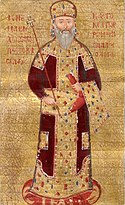Manuel II Palaiologos
| Manuel II Palaiologos | |
 | |
| Född | 27 juni 1350 Konstantinopel |
|---|---|
| Död | 21 juli 1425 (75 år) Konstantinopel |
| Medborgarskap | Bysantinska riket |
| Sysselsättning | Politiker, författare |
| Befattning | |
| Bysantinsk kejsare (1391–1425) | |
| Maka | Helena Dragaš |
| Barn | Zambia Palaiologina Johannes VIII Palaiologos (f. 1392) Theodoros II Palaiologos (f. 1396) Andronikos Palaiologos, Lord of Thessalonica (f. 1400 och 1400) Konstantin XI Palaiologos (f. 1404 och 1405)[1] Demetrios Palaiologos (f. 1407) Thomas Palaiologos (f. 1409) |
| Föräldrar | Johannes V Palaiologos Helena Kantakouzene |
| Släktingar | Andronikos IV Palaiologos (syskon) |
| Heraldiskt vapen | |
 | |
| Redigera Wikidata | |
Manuel II Palaiologos, född 27 juni 1350, död 21 juli 1425, var bysantinsk kejsare från 1391 till sin död. Han var gift med den serbiska prinsessan Helena Dragaš.
Manuel II vädjade förgäves till Västeuropa om hjälp mot turkarna. Timur Ienks angrepp på det osmanska riket räddade dock Konstantinopel för tillfället och gjorde det möjligt för Manuel II att återvända dit. [2]
Den 12 september 2006 höll påven Benedictus XVI en föreläsning vid Regensburgs universitet betitlad Faith, Reason and the University — Memories and Reflections. Påven citerade vid detta tillfälle en skrift författad av Manuel II år 1391:
| ” | Visa mig det nya som Muhammed har kommit med och du ser bara våld och omänsklighet, som exempelvis hans uppmaning att sprida tron med svärdets hjälp. | „ |
Källor
- ^ Darryl Roger Lundy, The Peerage.[källa från Wikidata]
- ^ Bra Böckers lexikon, 1977
| Företrädare: Johannes V Palaiologos | Bysantinsk kejsare 1391–1425 | Efterträdare: Johannes VIII Palaiologos |
Media som används på denna webbplats
Manuel II Palaiologos, Byzantine Emperor from 1391 until his death in 1425.
Författare/Upphovsman: Tom Lemmens, Licens: CC BY-SA 3.0
The double-headed eagle with the sympilema (dynastic cypher) of the Palaiologoi in the center. The double-headed eagle motif was used as the emblem of the Eastern Roman Empire (Byzantine Empire) during the 14th and 15th centuries, when ruled by the Palaiologos Dynasty.
Författare/Upphovsman: Ssolbergj, Licens: CC BY 3.0
Vexillum of the Roman Empire.



